 FIRST IN FLIGHT -- The X-: Was
a first in a series of rocket powered research aircraft built for the U.S.
Air Force and the National Advisory Committee for Aeronautics (NACA), which
in 1958 became the National Aeronautics and Space Administration (NASA).
Originally designated the XS-1 (for Experimental Sonic-1), it was built
by Bell Aircraft Company. On Oct. 14, 1947, the XS-1 with USAF Captain
Charles "Chuck" Yeager as pilot, was air launched at 21,000 feet. After
a brief check of the four 6,000 lb. thrust rockets, Yeager throttled the
plane up to 700 mph, becoming the first person to exceed the speed of sound
(Mach 1). The X-1s continued testing transonic flight until 1951, eventually
reaching a maximum speed of 957 mph and an altitude of 71,902 feet. Modified
versions continued flying until 1958. These tests provided data never before
available about the behavior of aircraft at transonic speeds. The aircraft
is on permanent display at the Smithsonian's National Air and Space Museum
in Washington, DC.
FIRST IN FLIGHT -- The X-: Was
a first in a series of rocket powered research aircraft built for the U.S.
Air Force and the National Advisory Committee for Aeronautics (NACA), which
in 1958 became the National Aeronautics and Space Administration (NASA).
Originally designated the XS-1 (for Experimental Sonic-1), it was built
by Bell Aircraft Company. On Oct. 14, 1947, the XS-1 with USAF Captain
Charles "Chuck" Yeager as pilot, was air launched at 21,000 feet. After
a brief check of the four 6,000 lb. thrust rockets, Yeager throttled the
plane up to 700 mph, becoming the first person to exceed the speed of sound
(Mach 1). The X-1s continued testing transonic flight until 1951, eventually
reaching a maximum speed of 957 mph and an altitude of 71,902 feet. Modified
versions continued flying until 1958. These tests provided data never before
available about the behavior of aircraft at transonic speeds. The aircraft
is on permanent display at the Smithsonian's National Air and Space Museum
in Washington, DC.
 BELL
X-2: Sitting on the ramp at what is now NASA's
Dryden Flight Research Center at Edwards Air Force Base, CA., is the X-2.
The X-2 was a swept-wing, rocket-powered aircraft designed to fly faster
than three times the speed of sound. Built by Bell Aircraft Co. for NACA
(now NASA) and the U.S. Air Force, it was flown to investigate the problems
of aerodynamic heating as well as stability and control effectiveness at
high altitudes and speeds in excess of Mach 3. There were two X-2s built,
constructed of K-monel steel, with an ejectable nose capsule rather than
an ejection seat, and skid type landing gear to make room for more fuel.
The ill-fated research planes were delayed for five years as a result of
manufacturing problems. The flight testing was terminated in less than
a month because of the loss of both aircraft. However, one of the X-2s
eventually performed as predicted during 1956, achieving an altitude of
126,200 feet and a speed of 2,094 mph before going out of control and crashing.
BELL
X-2: Sitting on the ramp at what is now NASA's
Dryden Flight Research Center at Edwards Air Force Base, CA., is the X-2.
The X-2 was a swept-wing, rocket-powered aircraft designed to fly faster
than three times the speed of sound. Built by Bell Aircraft Co. for NACA
(now NASA) and the U.S. Air Force, it was flown to investigate the problems
of aerodynamic heating as well as stability and control effectiveness at
high altitudes and speeds in excess of Mach 3. There were two X-2s built,
constructed of K-monel steel, with an ejectable nose capsule rather than
an ejection seat, and skid type landing gear to make room for more fuel.
The ill-fated research planes were delayed for five years as a result of
manufacturing problems. The flight testing was terminated in less than
a month because of the loss of both aircraft. However, one of the X-2s
eventually performed as predicted during 1956, achieving an altitude of
126,200 feet and a speed of 2,094 mph before going out of control and crashing.
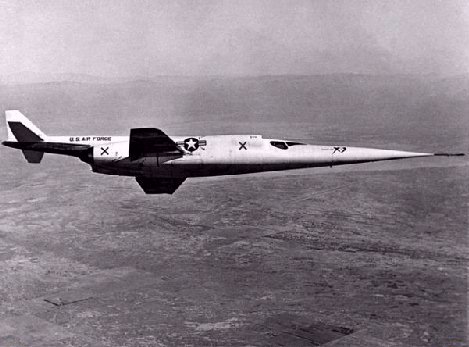 STILETTO
-- The X-3: with it's long, slender nose and stubby wings,
is flying over the Mojave Desert on a test flight from the NACA High Speed
Flight Station (later renamed the NASA Dryden Flight Research Center) at
Edwards Air Force Base, CA. The aircraft was manufactured by the Douglas
Aircraft Company and investigated the design features of an aircraft suitable
for sustained supersonic speeds, which included the first use of titanium
in major airframe components. It was delivered to the NACA High Speed Flight
Station in August of 1954. Although it made some significant contributions
to knowledge about "inertial coupling", a tendency to diverge from the
flight path at near supersonic speeds, the X-3 never lived up to it's expectations
as a Mach 2 aircraft.
STILETTO
-- The X-3: with it's long, slender nose and stubby wings,
is flying over the Mojave Desert on a test flight from the NACA High Speed
Flight Station (later renamed the NASA Dryden Flight Research Center) at
Edwards Air Force Base, CA. The aircraft was manufactured by the Douglas
Aircraft Company and investigated the design features of an aircraft suitable
for sustained supersonic speeds, which included the first use of titanium
in major airframe components. It was delivered to the NACA High Speed Flight
Station in August of 1954. Although it made some significant contributions
to knowledge about "inertial coupling", a tendency to diverge from the
flight path at near supersonic speeds, the X-3 never lived up to it's expectations
as a Mach 2 aircraft.
 X
PLANE -- The X-4: A single-place,
swept-wing, and semi-tailless airplane designed and built by Northrop Aircraft,
Inc., is on the ramp of what is now NASA's Dryden Flight Research Center
at Edwards Air Force Base, CA. Two X-4s were built to investigate the value
of this configuration at transonic speeds. The prototype's maiden flight
was on Dec. 16, 1948, and proved to be a mechanically unsound airplane,
but Ship 2 was very reliable. While being tested from 1950 to 1953, the
semi-tailless configuration exhibited inherent longitudinal stability problems
(porpoising) as it approached the speed of sound, but the data derived
from this research aircraft was important in the development of other high-performance
designs such as the X-15.
X
PLANE -- The X-4: A single-place,
swept-wing, and semi-tailless airplane designed and built by Northrop Aircraft,
Inc., is on the ramp of what is now NASA's Dryden Flight Research Center
at Edwards Air Force Base, CA. Two X-4s were built to investigate the value
of this configuration at transonic speeds. The prototype's maiden flight
was on Dec. 16, 1948, and proved to be a mechanically unsound airplane,
but Ship 2 was very reliable. While being tested from 1950 to 1953, the
semi-tailless configuration exhibited inherent longitudinal stability problems
(porpoising) as it approached the speed of sound, but the data derived
from this research aircraft was important in the development of other high-performance
designs such as the X-15.
 VARIBLE
SWEEP WINGS: The X-5 flying over the Mojave Desert,
was tested until 1955 at the NACA High Speed Research Station (later renamed
the NASA Dryden Flight Research Center at Edwards Air Force Base, CA).
Built by Bell Aircraft Company, the X-5's maiden flight was June 20, 1951.
The X-5, of which two were built, was the first aircraft capable of sweeping
its wings in flight and helped our understanding of wing-sweep angles of
20, 45, and 60 degrees at subsonic and transonic speeds. Although the aircraft
had vicious stall-spin characteristics it proved the viability of variable
sweep wings. Test results provided some of the design background for the
Air Force F-111 and the Navy F-14 Tomcat fighter.
VARIBLE
SWEEP WINGS: The X-5 flying over the Mojave Desert,
was tested until 1955 at the NACA High Speed Research Station (later renamed
the NASA Dryden Flight Research Center at Edwards Air Force Base, CA).
Built by Bell Aircraft Company, the X-5's maiden flight was June 20, 1951.
The X-5, of which two were built, was the first aircraft capable of sweeping
its wings in flight and helped our understanding of wing-sweep angles of
20, 45, and 60 degrees at subsonic and transonic speeds. Although the aircraft
had vicious stall-spin characteristics it proved the viability of variable
sweep wings. Test results provided some of the design background for the
Air Force F-111 and the Navy F-14 Tomcat fighter.
THE NEW GENERATION OF THE X-FAMILY
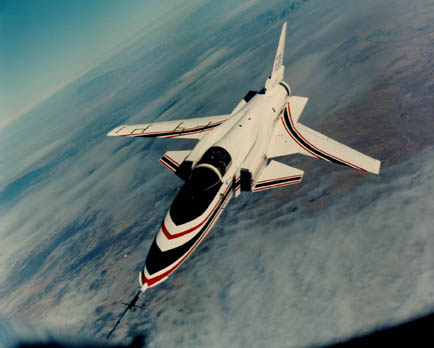 X-29a:
The experimental Grumman X-29A was one of the more unusual aircraft to
be tested in the skies over Edwards AFB in recent years. Its dramatic forward
swept wing (FSW) plantform was designed to provide greater maneuverability
at transonic speeds and better low-speed flying qualities than more conventional
aircraft. This layout only became possible after the development of composite
materials, advanced computers, and fly-by-wire technology. NASA and the
Air Force tested the aircraft from 1984 to August 1992.
X-29a:
The experimental Grumman X-29A was one of the more unusual aircraft to
be tested in the skies over Edwards AFB in recent years. Its dramatic forward
swept wing (FSW) plantform was designed to provide greater maneuverability
at transonic speeds and better low-speed flying qualities than more conventional
aircraft. This layout only became possible after the development of composite
materials, advanced computers, and fly-by-wire technology. NASA and the
Air Force tested the aircraft from 1984 to August 1992.
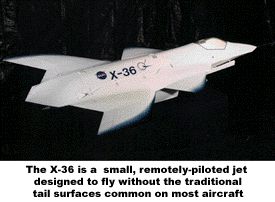 The
X-36: is a small, remotely-piloted jet designed to fly
without the traditional tail surfaces common on most aircraft. Built by
McDonnell Douglas' Phantom Works division in St. Louis, Mo., the aircraft
are 18 feet long with 10-foot wingspans, 3 feet high and weigh 1,270 pounds
each. The aircraft are each powered by a Williams Research F112 turbofan
engine that provides 700 pounds of thrust.
The
X-36: is a small, remotely-piloted jet designed to fly
without the traditional tail surfaces common on most aircraft. Built by
McDonnell Douglas' Phantom Works division in St. Louis, Mo., the aircraft
are 18 feet long with 10-foot wingspans, 3 feet high and weigh 1,270 pounds
each. The aircraft are each powered by a Williams Research F112 turbofan
engine that provides 700 pounds of thrust.
During the research, the aircraft were remotely controlled by a pilot in a ground station cockpit, complete with a head-up display. The pilot-in-the-loop approach eliminates the need for expensive and complex autonomous flight control systems.
Fighter maneuvers
Both 28-percent scale aircraft were put through fighter aircraft maneuvers
during the scheduled 25-flight program, to gather data on the performance
characteristics, especially agility, of tailless, fighter-type aircraft.
The project goal discovered enhanced technologies to improve the maneuverability
and survivability of future fighter aircraft.
McDonnell Douglas first proposed a tailless research aircraft to NASA in 1989. Following wind-tunnel tests to develop the technical breakthroughs required to achieve agile tailless flight, a cooperative agreement was signed for the X-36. McDonnell Douglas began fabrication of the two aircraft in 1994 following joint funding of the project under a roughly 50/50 cost-sharing arrangement.
The NASA Dryden Flight Research Center shared its experience on the Highly Maneuverable Aircraft Technology (HiMAT) program with NASA's Ames Research Center.
Having completed its flight test program the two X-36 UAVs will be stored in flyable condition at NASA Dryden.
The aircraft have flown a total of 31 flights, achieving speeds of up to 206 knots, an altitude of more than 20,000 feet and more than 40 degrees angle of attack.
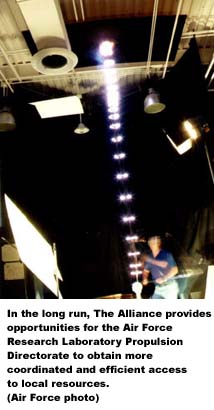 LASER: The long-range
vision of The Alliance’s memorandum of understanding is to provide a national
flight research and test center.
LASER: The long-range
vision of The Alliance’s memorandum of understanding is to provide a national
flight research and test center.
Maj. Gen. Dick Reynolds, AFFTC commander, said, "Our future holds the
promise of another ‘Golden Age’ of flight test, not unlike the period from
the mid-1940s to the mid-1960s, when X-planes, from the X-1 to the X-15,
were tested here at Edwards — right along side a long list of revolutionary
new jet-powered aircraft like the century-series fighters.
"The Joint Strike Fighter concept demonstrators, the X-32 and X-35, as well as the new wave of access-to-space experiments embodied in the X-33, X-34, X-37, X-38, X-40A and X-43, are all on our horizon," he added. "And I can’t leave out the CV-22 Osprey and Airborne Laser."
"The Alliance," Reynolds noted, "will play heavily in getting this work
done, and I predict that it will transform and evolve the Center in the
process. On the other side of that exciting new horizon, I expect Edwards
will be a more integrated, a more effective and an overall better research,
development and test center!"
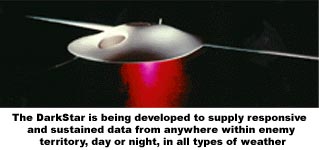 The DarkStar:
currently being tested at NASA's Dryden Flight Research Center at Edwards
Air Force Base, was designed to satisfy a goal of the Defense Airborne
Reconnaissance Office to supply responsive and sustained data from anywhere
within enemy territory, day or night, in all types of weather.
The DarkStar:
currently being tested at NASA's Dryden Flight Research Center at Edwards
Air Force Base, was designed to satisfy a goal of the Defense Airborne
Reconnaissance Office to supply responsive and sustained data from anywhere
within enemy territory, day or night, in all types of weather.
Developed by Lockheed Martin Skunk Works and Boeing Defense and Space Group, DarkStar has a wing span of 69 feet and is designed to fly above 45,000 feet at subsonic speeds on missions lasting more than eight hours. Unlike other UAVs, its guidance system is fully self-contained – actually more like a sophisticated automatic pilot. Remote control from a ground or air station is not necessary.
Designated as a Tier III Minus vehicle, DarkStar's operational flight parameters are classified. The vehicle will be capable of sustained high altitude surveillance and reconnaissance over high threat areas. It will operate at ranges of up to 500 nautical miles from the launch area and be able to loiter over the target area for greater than eight hours at altitudes in excess of 45,000 feet. This UAV will be capable of carrying either an electro-optical or Synthetic Aperature Radar payload, which will be interchangeable in the field.
The UAV will employ both wideband line-of-sight and moderate bandwidth satellite communications. In addition, the UAV includes launch and recovery elements, and a processing display system.
DarkStar arrived at the Dryden Flight Research Center on Sept. 14, 1995. On March 29, 1996, the craft made its first 20-minute flight, reaching an altitude of 5,000 feet and completing basic flight maneuvers.
DarkStar crashes
On April 22, 1996, during its second flight, DarkStar released brakes
and throttled up normally while taking off from one of the Edwards runways.
The main gear lifted off and the aircraft continued to accelerate on the
nose wheel (as it did on its maiden flight). The aircraft started an oscillation
in pitch either just before or after liftoff. Lift-off occurred at approximately
3,000 feet from the start of the takeoff roll.
Immediately after liftoff, the aircraft pitched up to almost 90 feet,
attaining more than 100 feet before it rolled off to the left. It crashed
and burned about 80 feet to the north of the runway, at the 2,000 feet
remaining marker. The orange "Black Box" was apparently thrown free of
the fire and a data tape in good health was recovered. In addition, telemetry
data was being logged on the ground.